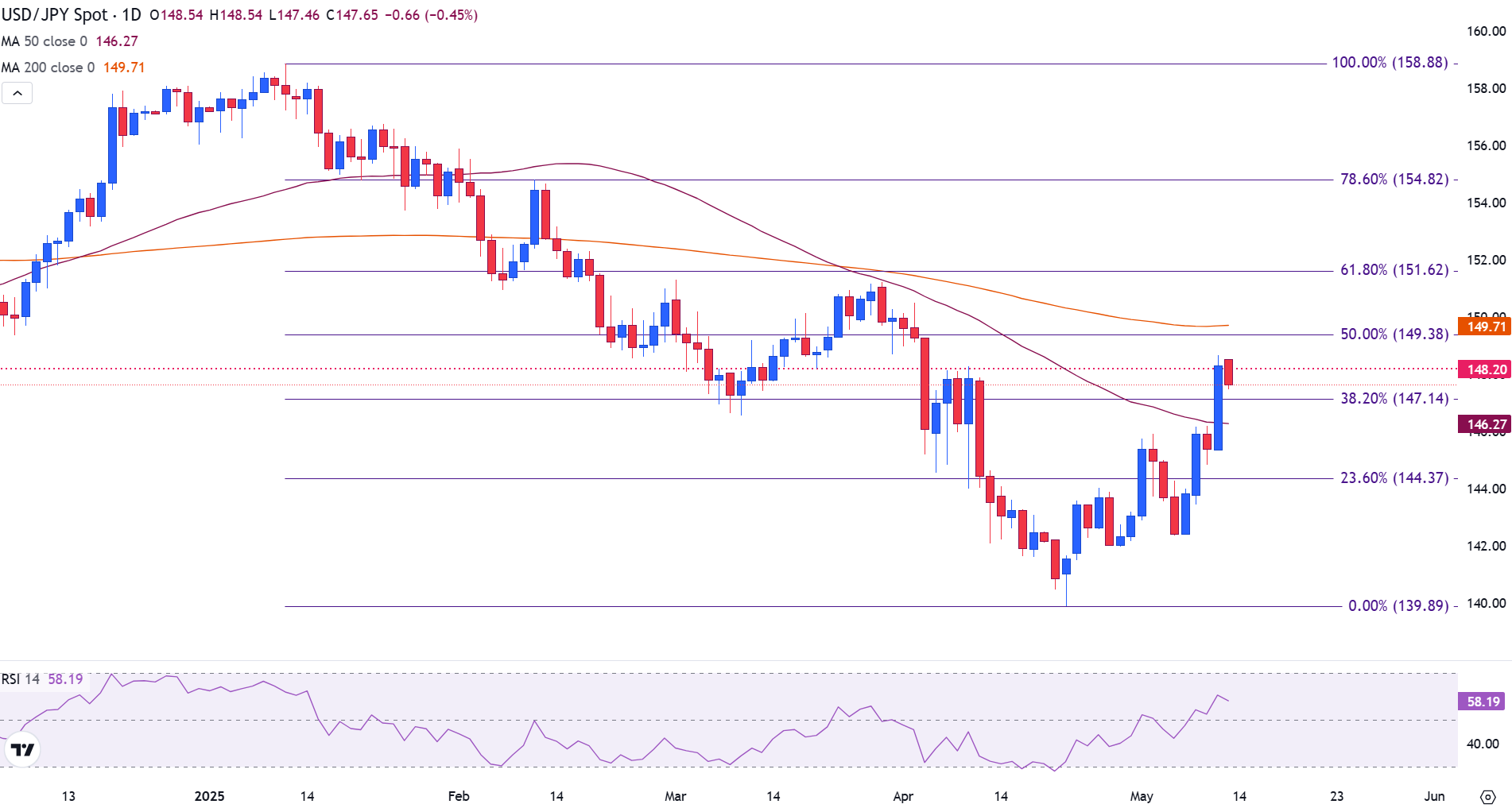- The USD/JPY falls below 148.00 while the softest data of the US CPI feed a moderate change in Fed’s rates expectations.
- The US dollar loses ground as treasure yields fall; The operators weigh the perspectives of feat cuts in front of the cautious perspective of the Boj.
- The markets expect Fed speeches and Japan data, including the PPI on Wednesday and GDP on Friday, to obtain more address.
The Japanese yen (JPY) advances modestly against the US dollar (USD) on Tuesday, since the USA inflation data softened than expected rekindled the speculation about federal reserve cuts (Fed) (Fed) cuts later this year.
At the time of writing, the USD/JPY has dropped 0.43% in the day, quoting below 148.00 after failing to extend the Monday rally driven by a feeling of improved global risk and the decrease in commercial tensions.
The movement follows the strong rebound on Monday, which had been driven by optimism around a temporary truce in tariffs between the US and China. However, the optimistic mood was attenuated by the US Consumer Price Index (CPI), which showed that inflation slowed down more than anticipated and weighed on the US dollar.
The mismatch of the US CPI revives the moderate perspective of the Fed
The APRICO IPC report of April revealed a moderation in inflationary pressures. The general CPI rose only 0.2% (monthly), below the 0.3% forecast and bouncing the fall of -0.1% of March.
In annual terms, inflation cooled to 2.3%, below the expected 2.4%.
The underlying IPC – which excludes volatile food and energy prices – also increased a monthly 0.2%, rendering less than the consensus of 0.3% and being stable at 2.8% year -on -year.
The data has strengthened the confidence of the market in which the Federal Reserve could begin to cut interest rates later this year. According to the CME Fedwatch tool, operators are now valuing a 25 basic points cut in September with greater conviction.
Attention focuses on the speeches of the Fed and Powell’s intervention on Thursday
The negative surprise in inflation has renewed the pressure on the US dollar, with the USD/JPy staggering after Monday’s earnings.
Investors are now directing their attention to a series of speeches of key Fed officials.
On Wednesday, Governors Christopher Waller, Philip Jefferson and Mary Daly are scheduled to speak, followed by President Jerome Powell’s comments on Thursday. The markets will be attentive to any moderate inclination that can further support the expectations of flexibility of politics.
The Japanese yen supported by the adjustment of yields, cautious perspective of the box
The Japanese Yen won ground modestly as the US treasure yields fell in response to the IPC report. A narrower interest rates differential reduces the attractiveness of the USD/JPy carry, offering some support to YEN.
However, the rising potential remains limited due to the persistently accommodating position of the Bank of Japan (BOJ). Without clear tightening signs by the BOJ, JPY’s profits can be limited.
Important Japanese data publications are coming, including PPI and GDP
Investors are also attentive to the economic calendar of Japan. The production price index (PPI) will be published on Wednesday, with forecasts that point to an increase of 4.0% year -on -year in April, slightly below 4.2% in March. A softer figure could relieve inflationary pressures and reduce the case for a hardening of the BOJ.
The attention will then be transferred to the publication of the Gross Domestic Product (GDP) of the first quarter of Japan on Friday. Economists expect a contraction of 0.1% intertrmetral after an increase of 0.6% in the fourth quarter of 2024.
A more pronounced deceleration could discourage the expectations of an increase in BOJ rates this year, while an upward surprise could offer a new support for the YEN.
The key resistance in 148.00 is maintained while the bullish impulse stops below the confluence of Fibonacci
The USD/JPY retreated on Tuesday after not exceeding the level of 148.20, the midpoint of the movement of the year to date.
This area has consistently acted as resistance and support, limiting profits at the end of March and triggering price reactions in early April, marking it as a significant technical pivot.
At the time of writing, the PAR is quoted by about 147.62, staying just above the 38.2% fibonacci setback level in 147.14, drawn from January 158.88 until the minimum of April 139.89.
The Simple Mobile (SMA) of 50 days in 146.27 provides the following dynamic support layer, reinforcing the short -term upward structure. Meanwhile, the relative force index (RSI) has dropped to 58.07, indicating that the bullish impulse remains intact, although it is no longer in overcompra territory.
USD/JPY DAILY GRAPH

And in Japanese faqs
The Japanese Yen (JPY) is one of the most negotiated currencies in the world. Its value is determined in general by the march of the Japanese economy, but more specifically by the policy of the Bank of Japan, the differential between the yields of the Japanese and American bonds or the feeling of risk among the operators, among other factors.
One of the mandates of the Bank of Japan is the currency control, so its movements are key to the YEN. The BOJ has intervened directly in the currency markets sometimes, generally to lower the value of YEN, although it abstains often due to the political concerns of its main commercial partners. The current ultralaxy monetary policy of the BOJ, based on mass stimuli to the economy, has caused the depreciation of the Yen in front of its main monetary peers. This process has been more recently exacerbated due to a growing divergence of policies between the Bank of Japan and other main central banks, which have chosen to abruptly increase interest rates to fight against inflation levels of decades.
The position of the Bank of Japan to maintain an ultralaxa monetary policy has caused an increase in political divergence with other central banks, particularly with the US Federal Reserve. This favors the expansion of the differential between the American and Japanese bonds to 10 years, which favors the dollar against Yen.
The Japanese Yen is usually considered a safe shelter investment. This means that in times of tension in markets, investors are more likely to put their money in the Japanese currency due to their supposed reliability and stability. In turbulent times, the Yen is likely to be revalued in front of other currencies in which it is considered more risky to invest.
Source: Fx Street
I am Joshua Winder, a senior-level journalist and editor at World Stock Market. I specialize in covering news related to the stock market and economic trends. With more than 8 years of experience in this field, I have become an expert in financial reporting.







